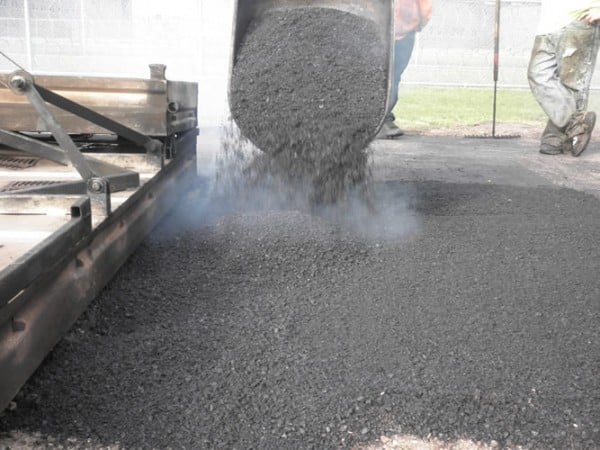Opening the Keys of Warm Mix Asphalt Modern Technology
Checking out the depths of hot mix asphalt innovation reveals a world where careful processes and exact formulas assemble to shape our roads and facilities. The fusion of binders, aggregates, and fillers isn't merely a construction task yet a strategic orchestration of resilience and performance. As we peer into the elaborate dance of elements, a tapestry of strength and sustainability unravels. But what exists underneath this surface area of asphaltic mastery, and what tricks wait to be introduced in the realm of leading innovations?
Value of Hot Mix Asphalt
Warm Mix Asphalt plays a vital function in contemporary framework development due to its resilience and cost-effectiveness. As the most commonly utilized paving product for roads, highways, and parking whole lots, Hot Mix Asphalt supplies a range of benefits that contribute to its relevance in construction jobs.
The durability of Hot Mix Asphalt comes from its composition, which consists of aggregates, binder, and filler products that are carefully picked and mixed to satisfy certain performance requirements. This exact combination causes a solid and versatile pavement that can withstand frequent usage without considerable wear and tear. In Addition, Warm Mix Asphalt is 100% recyclable, more boosting its sustainability and environmental benefits. In general, the relevance of Warm Mix Asphalt in facilities advancement can not be underrated, as it continues to be a foundation of modern construction techniques.
Components of Asphalt Mixes
The composition of asphalt blends is composed of meticulously picked aggregates, binder, and filler materials that are crucial for achieving specific efficiency requirements. Aggregates are the primary component of asphalt blends, providing toughness and security. The binder, commonly bitumen or asphalt concrete, holds the accumulations together and supplies adaptability and durability to the mix.
The combination and proportion of these parts play a substantial duty in figuring out the top quality and efficiency of the asphalt mix. Engineers thoroughly develop the mix to satisfy details needs, thinking about factors like web traffic quantity, climate problems, and pavement lifespan. Proper option and balancing of aggregates, binder, and fillers are vital for producing resilient, resilient asphalt sidewalks.
Mixing and Production Techniques

As soon as the accumulations are selected, the binder, often asphalt cement, is contributed to bind the products with each other. The binder's quality and quantity considerably affect the mix's stamina, resistance, and versatility to ecological elements. Additionally, fillers like hydrated lime or Portland cement might be incorporated to improve specific features of the asphalt mix, such as its workability or moisture resistance.
During production, the accumulations and binder are heated up, normally in between 250-325 ° F(121-163 ° C ), to promote mixing and make certain appropriate finish of the aggregates. The mixing procedure has to be comprehensive to attain an uniform mixture that advertises the desired efficiency attributes of the asphalt. Numerous methods, such as set blending or drum mixing, are used to attain regular and premium asphalt blends for building and construction projects.
Variables Affecting Asphalt Efficiency
Variables affecting asphalt efficiency encompass an array of variables that affect the longevity, longevity, and general top quality of asphalt sidewalks. One key aspect is the top quality of materials made use of in the asphalt mix. The type and resource of aggregates, the binder high quality, and the additives all play a substantial role in identifying the performance of the asphalt pavement. The rank of aggregates is important as it affects the mix's stability, workability, and resistance to rutting and breaking.

Layout considerations, such as pavement density and drainage, are necessary in making certain the long-lasting performance of the asphalt pavement. By meticulously considering these elements, designers and professionals can enhance asphalt performance and boost the service life of pavements.
Sustainable Practices in Asphalt Modern Technology
:max_bytes(150000):strip_icc()/asphalt-worker-134249388-58cdf96f5f9b581d723f2f33.jpg)
Furthermore, the advancement of warm-mix asphalt (WMA) innovations has actually gotten grip recently. WMA permits for the manufacturing and positioning of asphalt blends at lower temperature levels contrasted to standard hot-mix asphalt, resulting in reduced energy usage and greenhouse gas discharges. The use of permeable asphalt blends can help reduce stormwater drainage issues by permitting water to penetrate with the pavement and into the ground, advertising natural water regrading purification and charge processes. By implementing these sustainable techniques, the asphalt market can add to building a much more resistant and ecologically friendly facilities network.
Conclusion
In conclusion, hot mix asphalt innovation plays a vital role in modern-day infrastructure growth due to its toughness and cost-effectiveness. By very carefully balancing components, employing correct mixing techniques, and thinking about different variables, engineers can produce top quality asphalt mixes that hold up against heavy website traffic tons and severe weather problems. Welcoming sustainable methods, such as using recycled products and warm-mix modern technologies, better boosts the ecological kindness of asphalt technology.
Mixing and production methods in hot mix asphalt technology entail the specific mix and handling of aggregates, binder, and fillers to develop a durable and high-performance asphalt mix.Factors affecting asphalt efficiency include a range of variables that influence the durability, long life, and total top quality of asphalt sidewalks. Lasting methods in asphalt modern technology encompass various campaigns aimed at decreasing the ecological impact of asphalt manufacturing and paving processes. By including redeemed asphalt pavement (RAP) and recycled asphalt tiles (RAS) into brand-new asphalt mixes, the sector can substantially decrease the usage of raw materials and energy, while additionally reducing land fill waste.
WMA allows for the production and positioning of asphalt blends at reduced temperatures compared to standard hot-mix asphalt, resulting in minimized energy usage and greenhouse gas discharges.